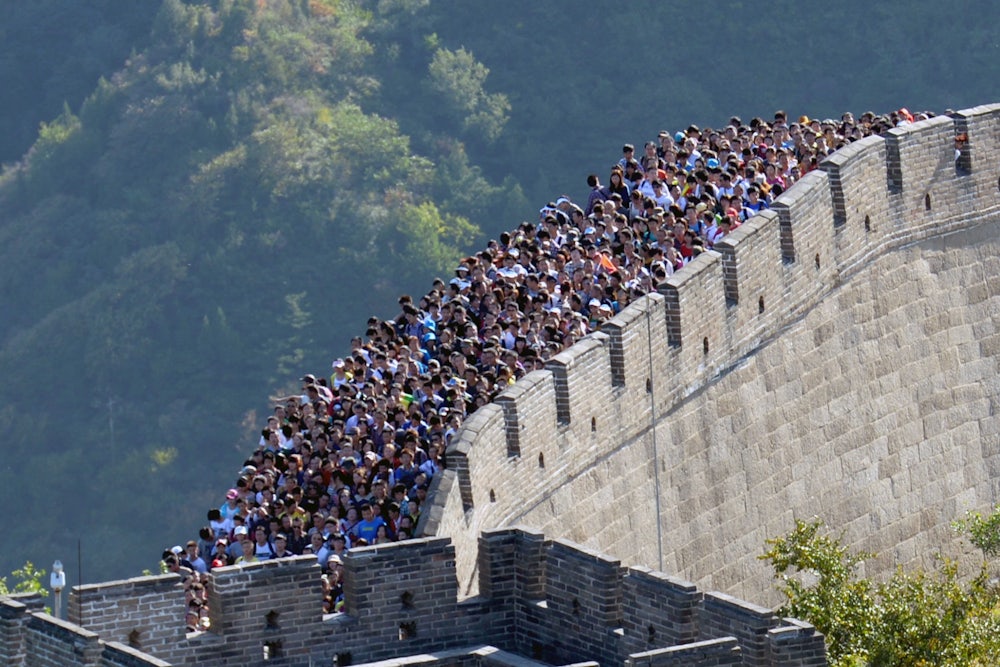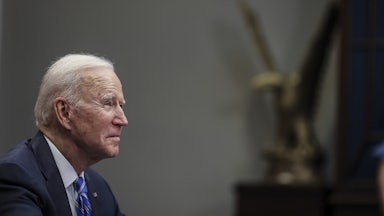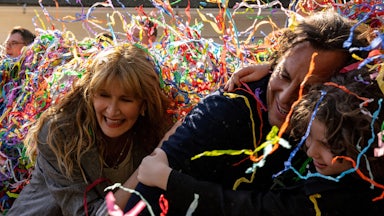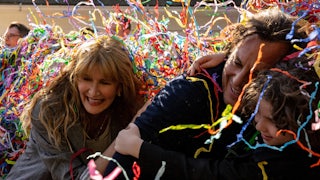It took a global pandemic for many of us to realize that we live in what Italian journalist and social theorist Marco D’Eramo calls the “Age of Tourism.” As he writes in his new book, The World in a Selfie: An Inquiry Into the Tourist Age, tourism is the defining industry of the twenty-first century. Tourism was an $8.8 trillion business in 2018, or 10.4 percent of global gross domestic product. It is also an industry upon which, D’Eramo writes, “a galaxy of institutions and businesses” depend, from hotels and restaurants to “the mock Gladiators who charge for photos in front of the Colosseum.” When the pandemic struck, flights were canceled and cities emptied, revealing just how reliant we all are on those strange creatures: tourists.
“Why hasn’t tourism’s importance fully registered before the Covid-19 pandemic and the lockdowns?” he asks. “Because tourists themselves are hard to take seriously.” The tourist’s ill reputation stretches back centuries. “Of all noxious animals too the most noxious is the tourist,” the Reverend Francis Kilvert wrote in his diary in 1870. “If there is one thing more hateful than another it is being told what to admire and having objects pointed out to one with a stick.” The tourist’s harmful impact on the places they visited was also apparent early on. “The Playground of Europe has been swamped with sightseers and the sanctuaries where Chaos and Old Night once reigned supreme have been desecrated and vulgarized,” wrote Alexander Innes Shand in 1903.
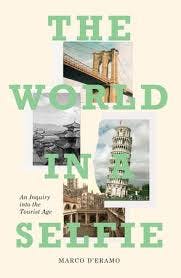
These complaints might easily have been made today. Even Kilvert’s characterization of tourists as “noxious animals” is echoed in the common description of “herds” of tourists getting off buses and cruise ships. And yet, strangely, most of those who malign tourists are often tourists themselves. D’Eramo takes up this paradox and brings into clearer focus the many confounding aspects of tourism: why we hate tourists and yet continue to travel, and why we divvy our leisure time into a structured regimen of sightseeing that resembles something like work.
D’Eramo is gentler on the figure of the tourist than many of his peers and predecessors. He locates the yearning to travel in a “positive alienation” that drives us to seek out the world. He also notes the class-based prejudice and racism embedded in tourist-hating. American tourists reserve their worst prejudice for Japanese tourists, and the wealthy save most of their hatred for the lower classes on package tours who aren’t sufficiently “off the beaten path.”
As we brace for a wave of postpandemic travel, D’Eramo refocuses our attention from the hateful tourist, who is almost all of us, toward tourism as a set of industries, with tentacles that reach everywhere, which has reshaped our cities and politics and almost every facet of life on earth.
Consider the ski mountain. “To ski down a snow-covered mountain is to partake in one of the most graceful sports, and all it requires is the pure force of gravity and the use of the planet’s contours,” D’Eramo writes:
Yet in order to achieve this almost immaterial elegance, it is also necessary to build imposing ski lifts, chairlifts and cable cars. Snow cannons are needed because, even with constant snowfall, skiing erodes the snow on the slopes—‘natural snow’ on its own would never suffice, and that’s even before we consider the effects of climate change. Then there are the roads that cut across valleys to reach the ski resorts, and the buildings that spread like weeds across the countryside.
Once-deserted land becomes a “metropolitan hive” filled with temporary inhabitants who use electricity, public services, and water. “Walking through the mountains in summer, one can see for oneself the devastation produced by these winter pursuits,” D’Eramo writes.
This is where D’Eramo is at his best, dissecting the consequences
of seemingly simple activities, and the impact of travel on the world at large.
The World in a Selfie is digressive, the chapters like a series of
meditations that touch on various aspects of travel and tourism. He considers
Las Vegas, and the city of Lijang in northwest China. He elaborates on the history of
tourism, its colonial roots and its early forms, as well as its contemporary
relationship to multiculturalism. His work is at times densely philosophical
(see the chapter titled “Long Live Alienation! Peeling the Hegelian Onion”) but
also whimsical (he writes briefly from the perspective of “an earthologist
friend,” studying humans as we might study extraterrestrials). The World in a
Selfie is occasionally disjointed, but this alternation between objects of
inquiry is also part of its charm and provides us with a sense of tourism’s
broad reach.
D’Eramo pays particular attention to how tourism has reshaped our cities over the course of the last century. He is not only troubled by destructive acts, like tunneling through mountains to create ski resorts, but also by acts of “preservation.” Some of his sharpest words are reserved for Unesco, the world heritage organization. He lambasts Unesco’s focus on conservation at the expense of contemporary life and its demarcation of “old cities” that become tourist traps and the backdrops for festivals. “Unesco’s ‘World Heritage’ listing is the kiss of death,” D’Eramo writes. “Once the label is affixed, the city’s life is snuffed out; it is ready for taxidermy.” Over the last 20 years, the number of sites designated by Unesco as worthy of conservation has exploded, producing ever more cities whose centers are artificially fixed in time.
All of this is related to one of tourism’s great conundrums: the problem of authenticity. What does it even mean to see an “authentic place?” And what does it mean to preserve that authenticity? D’Eramo devotes a chapter to the case of Lijang. After a devastating earthquake in 1996, Unesco declared Lijang’s “Old Town” a World Heritage Site, despite the fact that “there was nothing to ‘conserve’ or ‘preserve’ in the normal sense, as almost everything was destroyed by the earthquake.” With World Bank funding, however, the damaged high-rises in Lijang’s center were razed and reconstructed to build modern homes that had antique exteriors. Monuments were restored that had not even existed before the earthquake; the Mu Fu Palace, a residence that might have been built as early as the fourteenth century, became a primary attraction. But it hadn’t been destroyed in the 1996 earthquake—it had been destroyed in a succession of earthquakes, so that nothing was left of the original by the nineteenth century. Its “restoration,” then, was a kind of imagining of a distant phantom, with contemporary tourism in mind. Railways and motorways were built that led to Lijang, and in the space of 15 years, the small mountain town came to attract more tourists annually than all of Greece. Due to this influx of tourism, it has grown into a bustling city, and skyscrapers surround the manufactured old town. Meanwhile, the natural resources that surround Lijang have felt the strain: The nearby glacier of the Jade Dragon Snow Mountain has begun to melt.
Tourism’s environmental impact has become a point of concern even for the travel industry’s biggest boosters. “Over the last year, the travel world woke up to the implications of climate change and its contributions to global warming,” read the introduction of the “52 Places to go in 2020” package in The New York Times, which dropped shortly before the pandemic was supposed to bring the tourism industry to a halt. The result of this “waking up,” insofar as 52 Places was concerned, was a messy amalgamation of destinations seeking to market themselves as environmentally conscious (see: “Necker Island, the private island owned by Richard Branson, will finish rebuilding by April, and introduce uniforms made from recycled plastic found in ocean”) and places that are themselves disappearing, at least in part due to the effects of travel (“With that mile-thick ice sheet melting fast, and two new international airports slated to open in 2023, the time to explore an untrammeled, intact Greenland is now”). These contortions are evidence that many have entered a new era of guilt about travel and its consequences, particularly harmful emissions from airplanes. Even those deeply enmeshed in the industry have a growing sense that there is something inherently bad about tourism but have little intention to meaningfully change it.
D’Eramo mocks the idea of “sustainable travel” as oxymoronic but writes less than he might about the ruination of the world at the hands of what he calls “the world’s most polluting industry.” The environmental fallout from tourism is perhaps the pinnacle of the paradoxes he describes: the way in which individual yearning can become, in aggregate, one of the most destructive forces on earth. There are, certainly, better and worse ways to travel. There are ways to calculate individual impact, environmental and cultural, that are worthwhile. But there still needs to be a more radical shift in our thinking about travel, beyond the token Necker Islands of the world.
In his final chapter, D’Eramo envisions future generations looking back curiously at tourism. “The tourist will perhaps be a rather enigmatic figure from the past, like the haruspex, the almoner or the gleaner,” he writes. “Or perhaps it will be considered a temporary human illness, like that of the mad travelers of the nineteenth century.” What he means, he says, is not that humans will stop moving around, but that this age of tourism, wherein society and politics are geared so heavily toward it, will come to an end.
This was, after all, the year the planes were supposed to stop but didn’t. It was instead a year when many near-empty flights ran so that airlines wouldn’t lose expensive runway slots at Heathrow. It was a year when the coronavirus flared across Europe because of people’s insatiable need to travel. This year has not made it any clearer what the end of this age of tourism would look like, but it has made clear just how tenacious tourism’s hold on society has been—and how it simply cannot go on like this.
